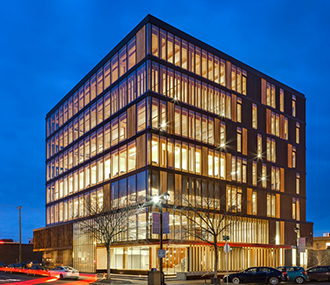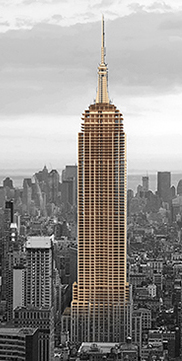In some ways, a wooden condominium tower planned for Chelsea has roots in an 18th-century barn.
Chris Sharples, a principal at SHoP Architects, remembers the barn as one of his first encounters with architecture, at his childhood home in Pennsylvania’s Chester County. He recalls marveling at its beautiful, exposed wooden beams, and it’s this intimate quality of bringing the “tectonic outside” inside that he hopes to replicate at 475 West 18th Street.
“It’s just amazing that we could actually think about building mid-rise, high-rise buildings out of this very traditional material,” he said. “We’ve come full circle.”
The Chelsea project is the first of its kind in New York City, but across the world, a growing number of developers and architects are trading steel’s luster for logs. The U.S. is rather behind other countries: Paris’ “Baobab” is projected to be the tallest wooden building in the world at 35 stories, followed by Vienna’s “HoHo” project at 24 stories. SHoP’s building — which is being developed by 130 134 Holdings LLC, Spiritos Properties, Arup, Icor Associates and Atelier Ten — is still in the early stages of approvals with the city and navigating building codes that cut wooden structures off at six stories.
For wooden buildings to catch on, people need to see them differently. A wooden tower can seem synonymous with a tinderbox, summoning antiquated yet vivid images of blazes that devastated cities. And taller ones can conjure up thoughts of towering infernos.
“Right off the bat, a wooden skyscraper faces significant marketing obstacles as many people’s first associations are the risk of fire and the killing of trees,” said Town Residential founder Andrew Heiberger. “It will be interesting to see how industry and consumer perceptions shift as efficiencies in both time and cost are realized.”
The benefits of timber towers are billed as environmental, constructional and aesthetic. The material could mean quicker, more efficient construction, which Sharples likened to a barn raising, since most of the building’s pieces are made offsite. That could significantly cut back construction costs in a city where they are at record-high levels. Wood, compared to steel, is also environmentally sustainable, as it is renewable. The material can be shaped to capture light, Sharples said, and it’s pleasing to the touch. It’s also got a je ne sais quoi to it. At “Wood at Work,” an October conference dedicated to the future of wood in architecture and urban building, Columbia University’s Kenneth Frampton, called wood “psychologically calming” and a “higher level of poetic construction.”

MGA’s Wood Innovation and Design Center
Though some might be skeptical at first, the Chelsea tower’s uniqueness will soon become a draw, said Douglas Elliman’s chief creative officer Roy Kim.
“Obviously, when you’re the first for anything, you’re kind of the guinea pig,” Kim, who is unaffiliated with the project, said. “People will want some reassurances about the stability of the building. I think once those issues are smoothed out, it will probably be a great thing.”
Even those with a stake in the project acknowledge it could be a tough sell.
Jeff Spiritos, principal at Spiritos Properties, said some people will at first dismiss the idea of living in a timber building. But he believes the project will appeal to environmentally-conscious types who can “look beyond the initial reaction.”
It’s still a bit early to predict what kind of interest wooden construction will ignite. Warburg Realty’s Jason Haber said he wouldn’t be surprised if more end-users than investors were attracted to such buildings, since the construction will potentially draw certain buyers looking for alternative living. But before investing or living in such a building, some key questions need answering, said Compass president Leonard Steinberg. His two main concerns: the structural integrity of an all-wood building that exceeds the usual height, and the building’s acoustics.
“When it comes to buildings that have more than three floors, I’d have to have much more information,” he said. “Until I have time to scrutinize them, I’d have doubts.”
At the same time, he said the new kind of construction presents a “tremendous marketing opportunity” — should brokers take a proactive approach in learning all that they can about wooden buildings before helping clients move in.
Proponents say that many of those leery about wooden construction don’t seem to understand a key point about the material used: This isn’t your mother’s timber.
“It’s gotten a bad rap for the fires we’ve seen in the light-framed construction,” said Amir Shahrokhi, project director at SHoP. “When you think wood, people think two-by-fours that you get from the lumberyard, and that’s not what we’re talking about.”
The Chelsea project will use mass timber, which consists of dense panels of engineered wood that often have an outer layer that will char in a fire and insulate the rest of the material from potential conflagration. Essentially, the material has built-in fire protection, which will be aided by sprinklers throughout the building, according to David Barber, a fire protection engineer with ARUP who is working on the project.
“Being the first of anything means that you go through a lot more scrutiny than you normally would,” he said. “The outcome is that it’s very safe.”

MGA’s rendering of a hypothetical Empire State Building made of wood
Michael Green, a champion of the wood construction movement, said changing how people think about wooden structures is a matter of going back to the ABCs of nature. Mass timber is heavy and thick and would react similar to a slow-burning log in a campfire.
“When it’s about fire, I often say: ‘Try building a fire with a lighter and a giant log,’” Green said. “When you tell a story like that, it reconnects people to a very practical reality.”
With more wooden projects on the horizon, the National Fire Protection Association has been studying how cross laminated timber — a type of mass timber — reacts to fire.
“The biggest difference is the timber contributes to the fire,” Amanda Kimball, research project manager of the Fire Protection Research Foundation “It actually could make it a bigger fire, given the right circumstances.”
For now, SHoP is starting relatively small at 10 stories, in part, to get people used to the idea of a wooden building, Sharples said.
Green, whose Vancouver-based firm is behind a 97-foot wooden tower in British Columbia, Canada, is taking a different approach. He’s involved in Metsä Wood’s “Plan B,” a project that reimagines skyscrapers as timber towers. Exhibits include a wooden Empire State building. The research is purely theoretical but is designed to show that a massive, iconic skyscraper could’ve been built differently.
“If you know you could build 102 [stories], suddenly 18 isn’t such a big deal,” he said. “Right now we’re just scratching the ankles of how tall these buildings could eventually be.”
